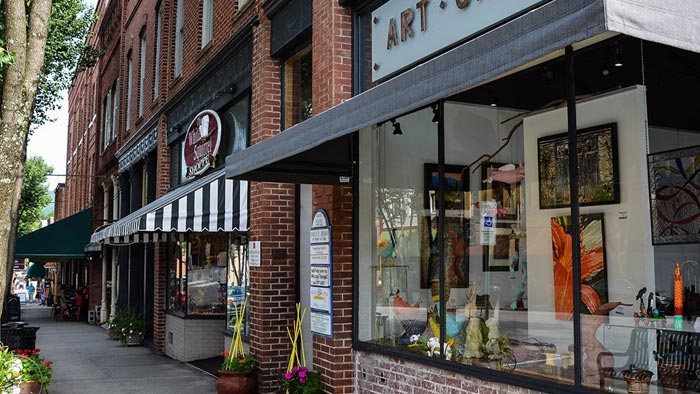Brevard the seat of Transylvania County, is a town like none other. It has all the wholesome, small town charm of times long past, but its diversity never ceases to surprise visitors: extraordinary live music, fantastic restaurants, irresistible antique shops, one-of-a-kind boutiques, abundant waterfalls and much more.
The Brevard Music Center and Brevard College’s Paul Porter Center for the Performing Arts host an incredible variety of entertainment: operas, musicals, jazz and classical concerts. The Brevard Little Theater and the Brevard Chamber Orchestra perform throughout the year. Transylvania County is also home to a thriving community of local musicians, many of whom you will discover playing in the gazebo on the court house lawn or in one of our local restaurants.
Many artisans have also chosen to make Brevard their home. In addition to several beautiful galleries downtown, there are numerous studios and shops to explore throughout Transylvania County.
This general area was settled in the early 1800s by Scots-Irish immigrants who were attracted by the rich soil and abundant game and natural resources. These early pioneers were surely awed by the variety of the land from lush green valleys to densely forested mountains to the headwaters of a chameleon, meandering river, the French Broad, that begins near present-day Rosman (a few miles south of Brevard) and flows from south to north.
By 1860, the population had grown sufficiently that residents sought to establish a town near Rock Springs. Transylvania County came into being in 1861 when state Representative Joseph P. Jordan introduced a bill to the North Carolina House of Commons to establish a new county from parts of Henderson and Jackson Counties. Having been born on a farm near Blantyre in Transylvania, it is no surprise that Jordan chose the name “Transylvania” for the new county. The name, “Transylvania,” comes from the Latin, “trans” for “across” and “sylvan” for “woods,”. Jordan’s bill also provided for the requested new town in the county. The bill was approved on February 15, 1861.
In 1899, the Transylvania Rail was built through the county, taking passengers from Brevard to Hendersonville in neighboring Henderson County. It took some of the nation’s wealthiest families to vacation at Lake Toxaway and carried much of the timber logged in the area to sawmills. Due to the amount of logging done in the area, lumber companies sawmills, and tanning companies became profitable businesses.
After World War I, Transylvania County got its first modern industry. Harry Strauss brought industrial jobs with the opening of a paper manufacturing plant located on the edge of the Davidson River. This plant called Ecusta has been a major employer in the past for years.
The town was named after Dr. Ephraim Brevard, a Revolutionary War surgeon. Born in 1744, Brevard studied medicine at the College of New Jersey (later Princeton University). He was known to be socially prominent. He joined the fight for independence when the British invaded the South. He was taken prisoner at the surrender of Charlestown, SC on May 12, 1780. In front of Brevard City Hall, a monument erected to Dr. Ephraim Brevard by his family declares that the doctor “Fought bravely and died a martyr to that liberty which none loved better and few understood so well.”
This region had been settled earlier when a grant of 640 acres had been made to Colonel Charles McDowell of Quaker Meadows in 1787. After 1790 a little colony was established along the Davidson River, and other settlers went to the forks of the French Broad. A private fort erected by John Carson was reassuring to these first settlers who were living so close to the Cherokee country. When Henderson County was formed, the settlers in its western area voted solidly for the French Broad or “River” site for a county seat. The district received the name Transylvania, a name possibly suggested by residents who had in mind the Transylvania colony in Kentucky.
Brevard was granted a U.S. Post Office on August 28, 1868, and its first Postmaster was William W. Moore. It has been in continuous operation ever since inception.
